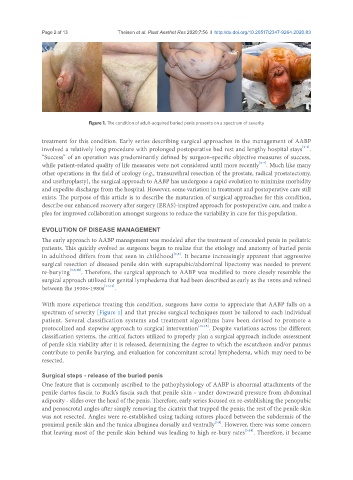Page 646 - Read Online
P. 646
Page 2 of 13 Theisen et al. Plast Aesthet Res 2020;7:56 I http://dx.doi.org/10.20517/2347-9264.2020.83
Figure 1. The condition of adult-acquired buried penis presents on a spectrum of severity
treatment for this condition. Early series describing surgical approaches in the management of AABP
[2-4]
involved a relatively long procedure with prolonged postoperative bed rest and lengthy hospital stays .
“Success” of an operation was predominantly defined by surgeon-specific objective measures of success,
[5-7]
while patient-related quality of life measures were not considered until more recently . Much like many
other operations in the field of urology (e.g., transurethral resection of the prostate, radical prostatectomy,
and urethroplasty), the surgical approach to AABP has undergone a rapid evolution to minimize morbidity
and expedite discharge from the hospital. However, some variation in treatment and postoperative care still
exists. The purpose of this article is to describe the maturation of surgical approaches for this condition,
describe our enhanced recovery after surgery (ERAS)-inspired approach for postoperative care, and make a
plea for improved collaboration amongst surgeons to reduce the variability in care for this population.
EVOLUTION OF DISEASE MANAGEMENT
The early approach to AABP management was modeled after the treatment of concealed penis in pediatric
patients. This quickly evolved as surgeons began to realize that the etiology and anatomy of buried penis
[2,8]
in adulthood differs from that seen in childhood . It became increasingly apparent that aggressive
surgical resection of diseased penile skin with suprapubic/abdominal lipectomy was needed to prevent
re-burying [3,9,10] . Therefore, the surgical approach to AABP was modified to more closely resemble the
surgical approach utilized for genital lymphedema that had been described as early as the 1800s and refined
between the 1930s-1980s [11,12] .
With more experience treating this condition, surgeons have come to appreciate that AABP falls on a
spectrum of severity [Figure 1] and that precise surgical techniques must be tailored to each individual
patient. Several classification systems and treatment algorithms have been devised to promote a
protocolized and stepwise approach to surgical intervention [13-15] . Despite variations across the different
classification systems, the critical factors utilized to properly plan a surgical approach include: assessment
of penile skin viability after it is released, determining the degree to which the escutcheon and/or pannus
contribute to penile burying, and evaluation for concomitant scrotal lymphedema, which may need to be
resected.
Surgical steps - release of the buried penis
One feature that is commonly ascribed to the pathophysiology of AABP is abnormal attachments of the
penile dartos fascia to Buck’s fascia such that penile skin - under downward pressure from abdominal
adiposity - slides over the head of the penis. Therefore, early series focused on re-establishing the penopubic
and penoscrotal angles after simply removing the cicatrix that trapped the penis; the rest of the penile skin
was not resected. Angles were re-established using tacking sutures placed between the subdermis of the
[3,8]
proximal penile skin and the tunica albuginea dorsally and ventrally . However, there was some concern
that leaving most of the penile skin behind was leading to high re-bury rates [3,14] . Therefore, it became

